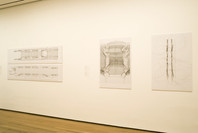Yokohama, a major port, asked Foreign Office Architects to design an iconic maritime terminal to serve as the main portal into and out of the city for the many visitors who travel there by sea. The building, projecting into Tokyo Bay like a long finger, was conceived as a folded, undulating landscape, and its design contrasts markedly with the city’s vertical architecture. The Port Terminal's warped surfaces have been sculpted by a vascular network of ramps—the building's circulation routes. The irregular horizontal surfaces bend at crucial points to function as supports for vertical loads, eliminating purely vertical structures on the site. The embarkation and disembarkation decks flank the terminal, feeding passengers into the system of interlaced loops in the interior. The roof functions as a public park; its gently rolling surfaces of wood and grass create a vaguely natural landscape.
The project is entirely indebted to the computer as a design tool. The architects embrace the computer for its ability to integrate information rapidly and to construct precise form–making instructions, designing a complex architectural entity in a relatively short amount of time. This ability is particularly evident in the series of isometric drawings, including this one, produced for the project. The drawing's lines illustrate the terminal's complex planar folds and spatial construction in a fashion that avoids the more pictorial approach of most three–dimensional architectural renderings.
Publication excerpt from The Museum of Modern Art, MoMA Highlights since 1980, New York: The Museum of Modern Art , p. 196.
